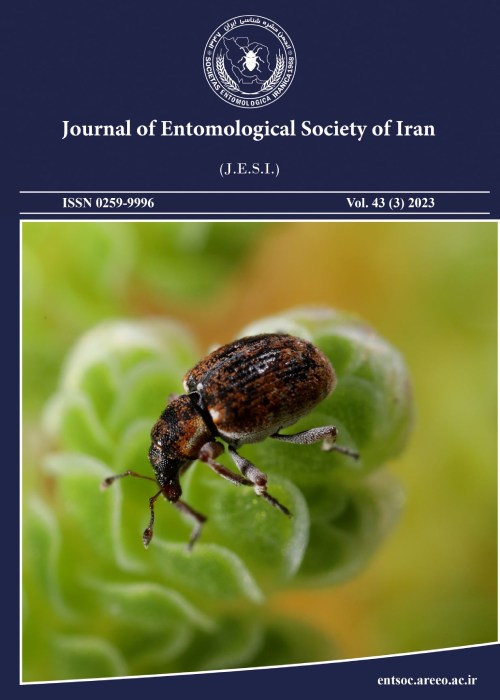Study on geographical distribution and population density of Stenopelmus rufinasus Gyllenhal, in paddy fields and aquatic ecosystems in northern Iran
Author(s):
Article Type:
Research/Original Article (دارای رتبه معتبر)
Abstract:
Azolla (Azolla spp.: Salviniaceae) is an aquatic fern that was introduced to the northern region of Iran with the aim of increasing the fertility of paddy fields, but due to suitable climatic conditions and the absence of natural enemies it became a problem in rice production and a destructive factor in aquatic ecosystems. In recent years, the biological control agent of this weed, Azolla weevil Stenopelmus rufinasus Gyllenhal (Curculionidae), was introduced in northern region of Iran. In this study, geographical distribution and seasonal population density of S. rufinasus in northern Iran were investigated through regular monthly sampling. The results showed that the time required to complete one generation in semi-field conditions is about two weeks. Both larvae and adults feed on Azolla. Azolla weevil is well distributed and established in the north regions of Iran and by feeding on Azolla, it has reduced its population in wetlands, permanent ponds and paddy fields. Comparing the population density of the weevil in three regions of Guilan province, indicated that the highest number of total density (667 insect in 1 kg Azolla) and adult (363 adults in 1 kg Azolla) belong to the central region of the province, while the density of larvae (397 larvae in 1 kg Azolla) in the eastern region of the province was higher than other regions. In the survey of the density in different cities, the highest density of total (2690 adults and larvae in 1 kg Azolla) and adult insects (2022 adults in 1 kg Azolla) was observed in Shaft city and the highest density of larvae (1920 larvae in 1 kg Azolla) was observed in the Rudbane of Lahijan. Based on the obtained results, the population density of the weevil is higher in spring and winter, which is not far from the mind considering the climatic conditions of the region and the sensitivity of Azolla to heat and low humidity. Based on the findings of this survey, the weevil has spread and settled well in the northern regions
Keywords:
Language:
Persian
Published:
Journal of Entomological Society of Iran, Volume:43 Issue: 3, 2023
Pages:
259 to 273
magiran.com/p2657367
دانلود و مطالعه متن این مقاله با یکی از روشهای زیر امکان پذیر است:
اشتراک شخصی
با عضویت و پرداخت آنلاین حق اشتراک یکساله به مبلغ 1,390,000ريال میتوانید 70 عنوان مطلب دانلود کنید!
اشتراک سازمانی
به کتابخانه دانشگاه یا محل کار خود پیشنهاد کنید تا اشتراک سازمانی این پایگاه را برای دسترسی نامحدود همه کاربران به متن مطالب تهیه نمایند!
توجه!
- حق عضویت دریافتی صرف حمایت از نشریات عضو و نگهداری، تکمیل و توسعه مگیران میشود.
- پرداخت حق اشتراک و دانلود مقالات اجازه بازنشر آن در سایر رسانههای چاپی و دیجیتال را به کاربر نمیدهد.
In order to view content subscription is required
Personal subscription
Subscribe magiran.com for 70 € euros via PayPal and download 70 articles during a year.
Organization subscription
Please contact us to subscribe your university or library for unlimited access!




